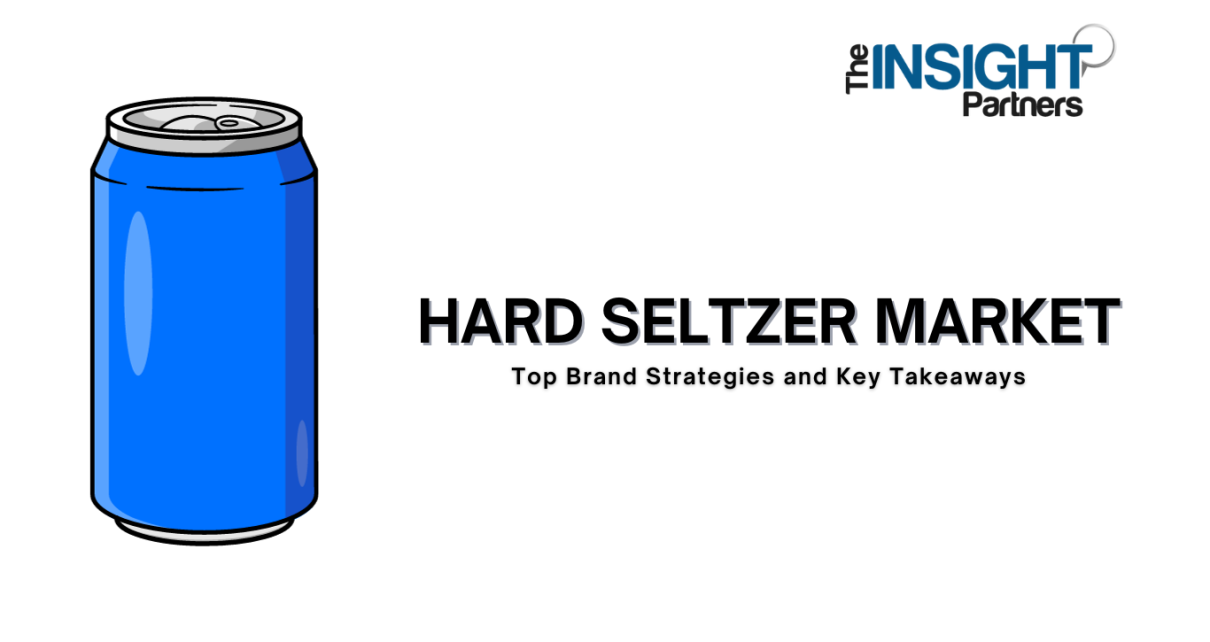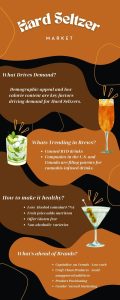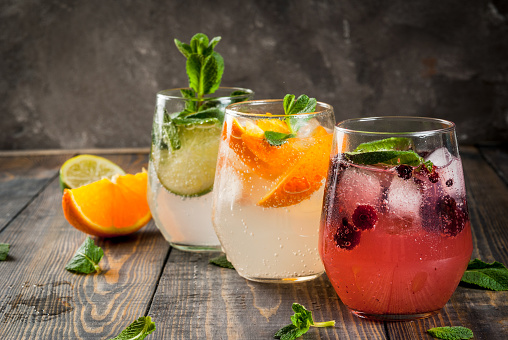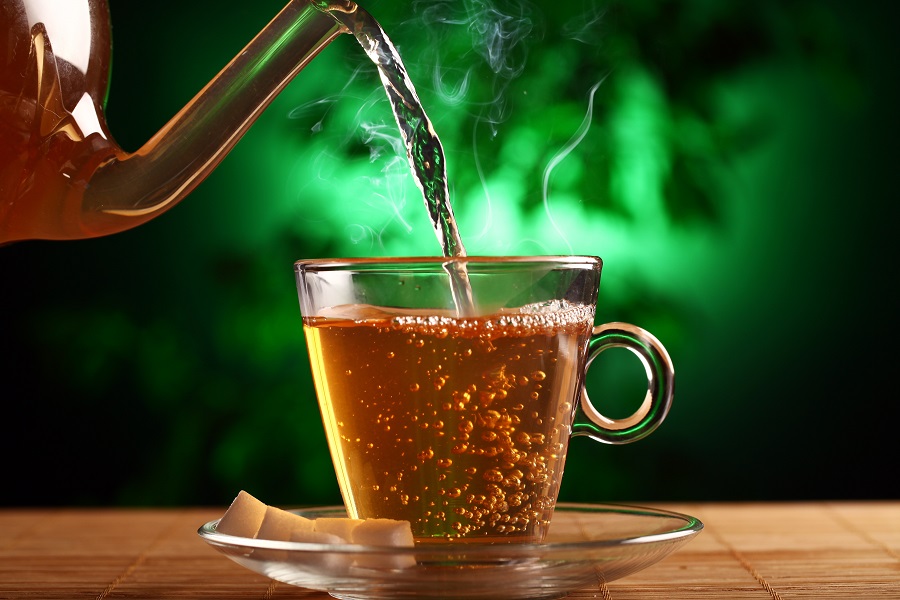The growing hard seltzer market is unleashing opportunities for F&B manufacturers. Hard seltzer is a blend of sparkling water, natural flavors, and easily drinkable concoction. It is a low-calorie, low-sugar, and often gluten-free alternative to cocktails. Ever since its first appearance in the market, hard seltzer has consistently improved as a profitable niche for companies. Consumers looking for an active lifestyle willing to try new beverages anticipated to turn the market for functional beverages in the next decade.
Hard seltzer gained popularity as it is easy to prepare. This refreshing beverage has generated a wider appeal to consumers looking for canned drinks to indulge in. Altering consumer preferences has pushed manufacturers to improve their product-based learnings. However, only a few hard seltzer market brand names pop up in response to these consumer queries. This signifies brand needs adequate efforts on the zest of hard seltzers to influence this momentous. Some of these brands are prevalent while others are new-fangled entrants.
Brand’s marketing strategies have pointedly played a role in making canned cocktails a popular brew. The escalating consumption of ready-to-drink (RTD) beverages has encouraged manufacturers to innovate. Consumers of hard seltzer also prefer non-alcoholic and alcoholic beverages. RTD cocktails have into more popular due to their expediency in on-the-go feasting.
What is Hard Seltzer? Is This Brew Healthy?
It’s a novel phenomenon in brews. A drink consisting of alcohol and carbonated water is hard seltzer. Fermented sugar and fruit juice are added to increase flavor. They usually contain 4%-7% of alcohol. This drink has emerged as an attractive marketplace for beverage companies. Consumers prefer wild-flavored drinks, and a range of delicious assortments are catered by companies.
Hard seltzers are made with malted rice, brewed cane sugar, and soda water. Fruit juice and nutrients are added to many seltzers. Most brands offer gluten-free seltzers. This makes it an ideal choice for people who avoid gluten. Non-alcoholic seltzers keep one fresh and give the water needed to the body. However, hard seltzers are not considered ideal for hydration.
Most hard seltzers contain low sugar and have a lower alcohol content than beer, ideally a good option for gluten intolerance. As a hard seltzer is an appealing combination of fresh fruits, sugar, and water it’s the perfect recipe to treat a hot day. The fruit content enriches its nutritional value. However, the addition of fruit juice doesn’t necessarily measure up to the value of fruit servings. Drinking high amounts of seltzers may lead to alcohol poisoning.
Consumers consciously choose their drinks based on sugar and nutritional content. Improvisation of health benefits can turn in favor of brands, availing them of a wider consumer base. However, the American Institute for Cancer Research has stated all types of alcohol can increase the risk of cancer. Consumers are likely to shift from alcoholic to no-alcohol brews. By being informative about ingredients, businesses can fetch high credit on transparency scales. The informative product packaging can be a medium to win consumer trust in the hard seltzer market.
Binge drinking is a major concern when consumers have a large variety of drinks to choose from. It’s appreciated that hard seltzers don’t contain many calories, but it doesn’t even high in nutrients. Alcohol in hard seltzer leads to dehydration. Consumers often tend to overindulge in seltzers, but moderation is very important for overall gut health.
Strategic Approaches by Top Hard Seltzer Market Brands
- Product Innovation
Volley, Vizzy, Flying Embers, Straightaway, Juneshine, Press Premium, and truly are some top seltzer companies globally. They demonstrate and renovate around the sugar content and flavors of drinks to gain a competitive edge. The specialized high-quality canned drinks are anticipated to gain traction in the coming years.
Flying Embers have infused botanical bitters with artificial flavors. Other brands such as Wild Basin have introduced coconut and lime flavors that are appreciated by many consumers. Hard seltzer market players also working on the fusion of different fruit flavors such as pineapple, cherry, and lime. Vizzy’s vitamin C-enriched seltzer is attracting bulks of sales.
However, customers may have pre-perceptions about hard seltzers. Brands such as OG hard seltzer became an exception to those preconceived notions and generated a loyal consumer base. A diversified product portfolio and expanded distribution channels shaped the brand’s success.
- Product Packaging
Even though taste remains a top factor in beverage adoption, packaging will still have a crucial stake in determining product sales. Especially when companies intend to attract new customers who have never tried their products, packaging can have a prominent role in attracting the target audience.
Cellulose and nanocomposite packaging are anticipated to gain traction of attention in the coming years. The metal cans segment is expected to remain dominant as brew packaging in coming years. Metal cans are easy to carry and handle, and satisfy functionality parameters. These can offer protection to brews from external factors such as light, temperature, and chemicals.
Glass packaging is anticipated to grow lucratively as they are associated with premium effects. Transparent glass bottles can be decorated to create product appeal. The feel of sophistication associated with glass bottles elevates the experience of consumers.
- Strategic Marketing
Product marketing has played a central role in the hard seltzer market brand’s success. Companies prefer social media and content marketing tactics to reach the right targeted audience. Truly hard seltzer marketing has used a tagline- “keeping vibes high and drinks cold”. This hard seltzer marketing attributed to the brand’s success in terms of its increased reach. F&B brands have to build relationships with customers, raise their brand awareness, and launch new offerings. Advertising campaigns targeting ideal customers tend to attract more sales in the hard seltzer market.
Hard Seltzer Market Regional Growth Prospect

North America is a highly competitive marketplace for seltzer brands with huge revenue generation potential. Acceptance of alcoholic beverages and lower alcohol content drinks have contributed to growth in this industry. Top hard seltzer market brands have responded quickly to health-conscious consumers with exotic flavors in the recent past. Revenue-wise wise North America held a valuation of USD 1700 million in 2021. The surge in consumer demand for fewer calorie options are driver of progress in this industry. The regional market in North America is highly competitive due to the presence of major F&B players. Foremost brands studied changing buyer preferences and modernized their products to maintain their market share.
Europe is the next attractive market producers should look for. Both local and international companies are likely to gain acceptance from consumers. It’s anticipated that Europe’s hard seltzer market share will surpass a value of USD 450 million in 2028. Consumers in Europe are shifting to healthy substitutes. UK, France, and Germany are leading hard seltzer markets in the European region. There is growth in acceptance and penetration of e-commerce favoring a share of the UK hard seltzer market.
Asia Pacific is another region for growth in this industry. Altering lifestyles, urbanization, and consumer awareness are likely to support the growth of hard seltzer companies in the coming years. Changing lifestyles and the influence of ‘Western diet’ preferences pouring demand for functional beverages in this market. The hard seltzer market is in the initial growth phase and manufacturers in the F&B industry are expected to gain immense growth in the coming years.
What’s Ahead of Hard Seltzer Market Players?
- Capitalize on Trends
Companies need to find trends where they can capitalize. The “Going green” trend has emerged to take the idea that there is more in beverages than wine and beer. These trends have created more opportunities for hard seltzer market participants.
Low-carb demand is motivated by the trend of keto diet. Companies can address the needs of carb-conscious consumers with innovative drink options. Low-carb beer alternatives have recently been introduced in the market and got tremendous response from people. Hard seltzer brands can be more informative about their ingredients as alcoholic brands are not putting their information in products. This could be a competitive advantage for hard seltzer market players.
Attention to unique selling points can attract investors. Customers should be able to recognize the unique selling points of brands. This is crucial for companies to have a competitive edge in the long term.
- Craft Clean Products
Consumers are conscious of what they choose and what impact they are going to have on the environment. Clean products are seen to have wider demand due to environmental concerns. “Clean” has emerged as a key tactic used by F&B manufacturers to attract consumers. Hard seltzer brands have the opportunity to mark their product under a clean category. This can differentiate them as a clean alternative to traditional alcoholic drinks. Functional beverages in the U.S. are mandated to contain ingredients that are safe for consumption. Food and Drug Administration (FDA) has raised concerns about the use of unapproved additives in drinks. The use of unapproved ingredients can make products illegal to be sold in the U.S.
- Position Product in Market Gap
Marketers of hard seltzer can position products in existing market gaps. Straightforward product positioning is likely to fetch more results. Before the introduction of hard seltzer, the market for canned drinks was limited. Companies need to find a niche and try to own it for long-term success. For instance, spirit-free pairings are marking presence on extensive restaurant menus.
Non-alcoholic beverages are anticipated to increase drink options in coming years. Identification of target audience and customer location is important for companies to generate brand position. Understanding ‘where a brand stands’ and ‘what consumers expect’ are key cornerstones in marketing success.
- Gender Neutral Marketing
Brands expected to realize the sales of hard seltzer market is determined less by gender, and more by lifestyles. It was observed that white claw had become a personality trait in both genders. Marketing strategies should be focused on the functionality of the product irrespective of the customer’s gender. It’s time for companies to comprehend that the gender-neutral trend is here to stay for longer.
Some players have already recognized this and focused on building an immersive brand experience instead of purely focusing on certain customer segments. Most of the hard seltzer consumers are millennials. More than half of Gen Z and millennials consider a binary division of gender as outdated. Brands expected to integrate this trend into their promotion strategies.
Future Outlook
New products and partnerships are expected in ‘cannabis focus’. Many companies in the U.S. and Canada are filing patents for ‘cannabis-infused drinks. Companies with a cannabis focus are predominantly alcoholic brands. However, a significant amount of investment funneled into non-alcoholic drinks is expected to generate new hard seltzer market revenue streams. Probiotic beverages are expected to grow and will cross over USD 77 billion in 2025. Millennials remain key target consumers for hard seltzer brands, as they focus on more mocktail varieties and healthy options.
Beverage makers need to experiment with new ingredients to avoid any external negative impacts of sugar. The desired sweetness and texture are goals targeted by companies. However, companies also need to include calorie count consideration that usually bothers consumers. Stevia and allulose are some already available alternatives for sugar.
In addition to exotic flavors, consumers may expect novel cocktail-inspired drinks in the coming time. Companies who choose to expand their product offerings to new mojitos, and vodka sodas are likely to report their wellbeing. Mixed drinks are expected to gain wide acceptance from consumers in the coming years. An increase in variety and innovation in flavors are key strategies companies should work hard on. We expect large investments in white hard seltzers and to ready-to-drink (RTD) category.
The beverage industry is undergoing a huge wave of disruption. The changing consumer choices and health concerns influence their purchases. Consumer behavior also impacts the marketing, sales, and production tactics of beverage companies. Consumers need to be aware of the “health halo” effect that is likely to create a false impression about a brand. Some companies decisively create this perception that their product is good for health without any evidence. Beverage companies often use this tactic to increase their sales and direct consumer purchases. As the climate concern has heated global discussions, the hunt for eco-friendly ingredients is likely to continue. Both Startup and established players are likely to focus on healthy beverage making.
References:
American Institute of Cancer Research- Alcohol can increase the risk of cancer
Statista – Penetration of e-commerce
Food and Drug Administration (FDA)- Unapproved additives
Gundersen Health System- Health halos: What they are and why you need to avoid them
Truly Hard Seltzer- Keeping vibes high and drinks cold




